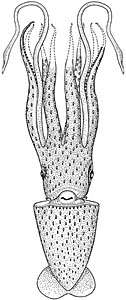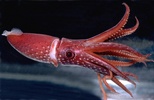Histioteuthis cerasina
Richard E. Young and Michael VecchioneIntroduction
Histioteuthis cerasina appears to be rather common in Central and Eastern Pacific tropical waters.Characteristics
- Head
- Beaks: Descriptions can be found here: Lower beak; upper beak.
- Beaks: Descriptions can be found here: Lower beak; upper beak.
- Photophores
- Head photophores Type 2a (2 photophores in Midline Series, 3 in Basal Arm IV Row).
- Suckers
- Rings on enlarged median suckers of manus with 30-35 equally small, sharp, narrow conical teeth in small squid and 40-60 teeth in large squid.
Comments
More details of the description can be found here.Species of the corona-group are distinguished by the following characteristics:
- Photophores
- Type 2 head-photophore pattern (e.g., 2 Midline Series photophores, 3 or 4 Basal Arm IV Row photophores and no rogue photophore) .
- Basal Row with 7 photophores.
- Right Basal Series present.
- Arms IV without separate series of compound photophores at arm tip.
- Compound photophores on anterior half of ventral mantle uniform in size.
- Arms
- Suckers with smooth rings on arms I-III except at distal ends and occasionally on basal suckers.
- Suckers of arms IV with dentition.
- Tubercles
- Absent
The following table compares differences among members of the corona-group. H. cerasina and H. corona are very similar but occupy different oceans.
| Character | Photophores Arms IV No. of series | Suckers Dentition Manus, large |
|---|---|---|
| H. corona | 3 | 33-38 |
| H. berryi | 4 | 28-34 |
| H. cerasina | 3 | 40-60 |
Except for the analysis of head photophores, this description is from Voss (1969) and Voss, et al. (1998).
Distribution
Geographic distribution
Type locality: Southeastern Pacific, 00°01'S, 84°59'W. H. cerasina is found in the central and eastern equatorial Pacific, and the eastern southern tropical Pacific (Voss, et al., 1998).References
Voss, N. A. 1969. A monograph of the Cephalopoda of the North Atlantic: The family Histioteuthidae. Bull. Mar. Sci., 19: 713-867.
Voss, N. A., S. J. Stephen and Zh. Dong. 1992. Family Histioteuthidae. p. 73-91. In: Sweeney, M. J., C. F. E. Roper, K. M. Mangold, M. R. Clarke and S. V. Boletzky (eds.). "Larval" and juvenile cephalopods: a manual for their identification. Smithson. Contr. Zool., No. 513: 1-282.
Voss, N.A., K. N. Nesis, P. G. Rodhouse. 1998. The cephalopod family Histioteuthidae (Oegopsida): Systematics, biology, and biogeography. Smithson. Contr. Zool., 586(2): 293-372.
Title Illustrations

| Scientific Name | Histioteuthis cerasina |
|---|---|
| Reference | modified from Voss, N. A., S. J. Stephen and Zh. Dong. 1992. Family Histioteuthidae. p. 73-91. In: Sweeney, M. J., C. F. E. Roper, K. M. Mangold, M. R. Clarke and S. V. Boletzky (eds.). "Larval" and juvenile cephalopods: a manual for their identification. Smithson. Contr. Zool., No. 513:1-282. |
| View | ventral |
| Size | 48 mm ML |
| Type | holotype |
| Scientific Name | Histioteuthis cerasina |
|---|---|
| Location | Hawaiian waters |
| Specimen Condition | Live Specimen |
| View | Right side |
| Image Use |
 This media file is licensed under the Creative Commons Attribution-NonCommercial License - Version 3.0. This media file is licensed under the Creative Commons Attribution-NonCommercial License - Version 3.0.
|
| Copyright |
©

|
About This Page

University of Hawaii, Honolulu, HI, USA

National Museum of Natural History, Washington, D. C. , USA
Page copyright © 2015 and
 Page: Tree of Life
Histioteuthis cerasina .
Authored by
Richard E. Young and Michael Vecchione.
The TEXT of this page is licensed under the
Creative Commons Attribution-NonCommercial License - Version 3.0. Note that images and other media
featured on this page are each governed by their own license, and they may or may not be available
for reuse. Click on an image or a media link to access the media data window, which provides the
relevant licensing information. For the general terms and conditions of ToL material reuse and
redistribution, please see the Tree of Life Copyright
Policies.
Page: Tree of Life
Histioteuthis cerasina .
Authored by
Richard E. Young and Michael Vecchione.
The TEXT of this page is licensed under the
Creative Commons Attribution-NonCommercial License - Version 3.0. Note that images and other media
featured on this page are each governed by their own license, and they may or may not be available
for reuse. Click on an image or a media link to access the media data window, which provides the
relevant licensing information. For the general terms and conditions of ToL material reuse and
redistribution, please see the Tree of Life Copyright
Policies.
- Content changed 11 October 2015
Citing this page:
Young, Richard E. and Michael Vecchione. 2015. Histioteuthis cerasina . Version 11 October 2015 (under construction). http://tolweb.org/Histioteuthis_cerasina/19803/2015.10.11 in The Tree of Life Web Project, http://tolweb.org/










 Go to quick links
Go to quick search
Go to navigation for this section of the ToL site
Go to detailed links for the ToL site
Go to quick links
Go to quick search
Go to navigation for this section of the ToL site
Go to detailed links for the ToL site